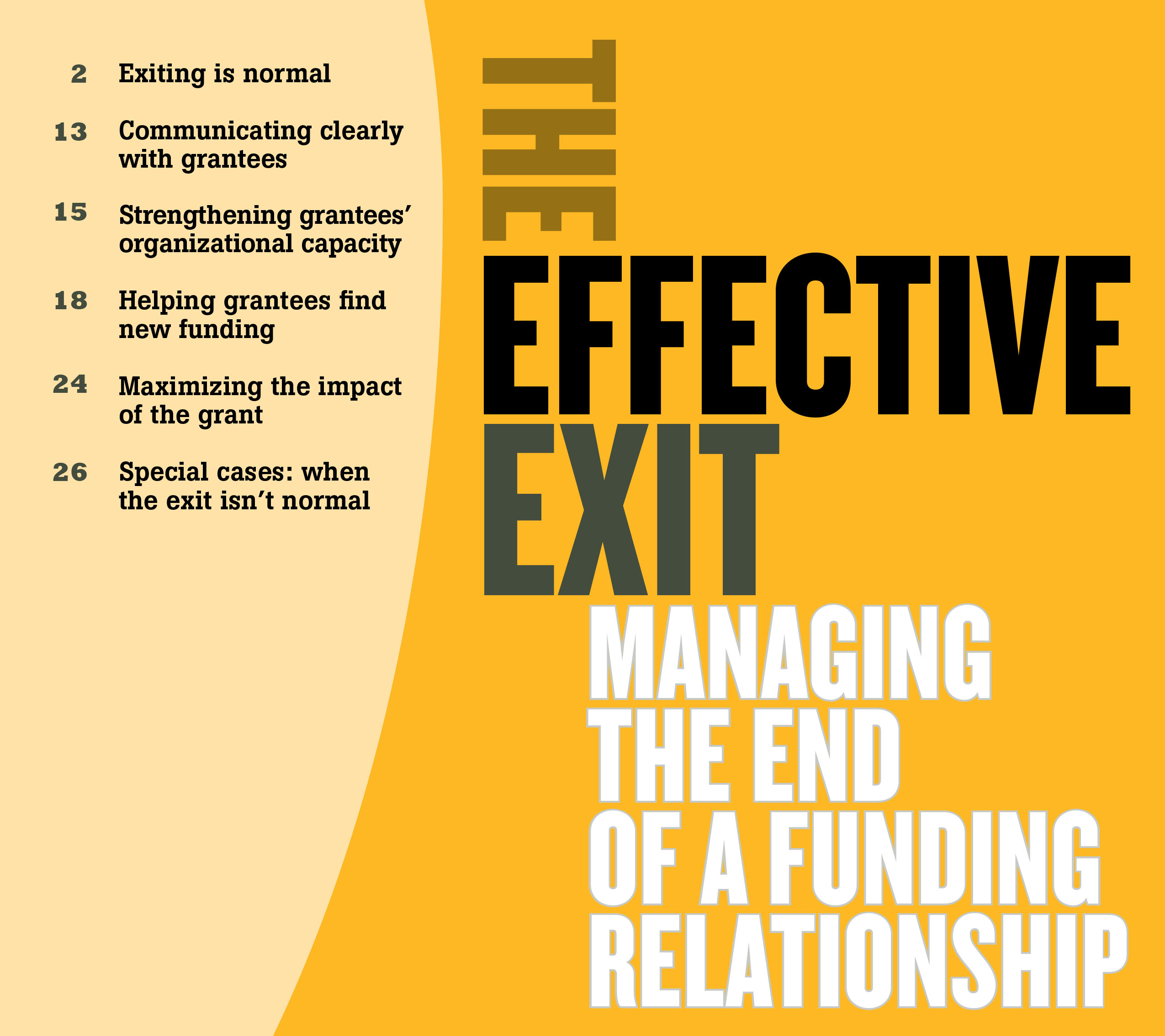Helping Grantees Break the Ice with New Funders Ensuring Sustainability at the End of a Funding Relationship
Some people say that the one time you can't help a grantee raise money is the moment when help is needed most - as the funding relationship is coming to an end. Sometimes, however, a grantmaker decides to step into the breach and help a soon-to be former grantee find new sources of funding.
SPECTACULAR RESULTS
At the end of two years, the grantee had produced spectacular results. They've increased their membership by 50 percent, and they've done a tremendous job of reaching out to the Latino population. They hired bilingual organizers, and they also put together a plan to begin to diversify their funding base. The predatory lending work had gone well: Our investment of $100,000 had resulted in something on the order of $12 million to $15 million in savings for people who would otherwise have been ripped off. That seemed like good leverage from a relatively small grant.
Yet all this good news "was actually a little horrifying to us," the grantmaker conceded, "because we weren't really planning to fund them again." In the two years since the grant had been made, the foundation's approach to community engagement had shifted away from local work, and its take on predatory lending had evolved. Instead of "cleaning up the mess made by predatory lenders," the foundation was now more interested in "being proactive about going in there and offering products that would displace predatory lenders in the marketplace." Despite its good work, this particular grantee was "still running around trying to fix the problems and use stories from victims to put pressure on lenders to behave better."
Would the organization be willing to change its approach? "We asked them," said the grantmaker, "but they weren't interested in doing lending." Their attitude was "commendable, in a way. They weren't going to lie to me and tell me they wanted to do the stuff I wanted them to do. Instead, they said, "This is outside our area of expertise, and we would prefer to stick to what we're good at. Maybe you could help us to do more of that."
The grantmaker featured in this case works for a national foundation that supports programs in economic empowerment and community engagement. The grantee is a community-organizing group that operates across a Midwestern state, mainly in rural areas but increasingly in cities, to address issues of economic justice.
The relationship got started, the grantmaker recalled, "because we knew we wanted to do more grantmaking in the middle of the country, and we had heard good things about this group. A colleague and I went out to visit them and were really impressed. It's a diverse, member- driven organization. It was almost entirely funded by members. They were doing a lot of important rabble rousing around issues that would not otherwise have made it onto the policy landscape."
The foundation made a two-year grant to support "two strands of work: a local organizing campaign against predatory lending practices and the creation of a statewide organizing coalition. In addition, we asked them to expand their membership in the Latino community, which was growing fairly rapidly in what has historically been a very white state. They said, sure, they'd make an effort to reach out to Latinos."
A GOOD FAITH PROMISE
The grantmaker knew his foundation couldn't keep funding the grantee's work indefinitely, but he also felt that he "couldn't just leave them at that point. We said, 'Okay, we'll give you a second grant, but you have to know going in that this is the last funding you're going to get from us. Our work is moving in a different direction, and we don’t really do a lot of funding for local groups. But we're impressed with your work, and we want to keep the relationship alive. We'll make a good faith promise to help you cultivate other funders.'"
At the time, he didn't know what that would entail. About six months later, the grantmaker got a call from the grantee, who wanted to brainstorm ideas for attracting new funders. He suggested that the grantee think about holding "a special briefing for funders as part of an event you're having anyway."
The group's 30th anniversary was coming up. They agreed it would be the perfect backdrop for a briefing for local funders on philanthropy and community organizing. And so, despite the considerable time and travel involved, the grantmaker agreed to come. He also invited a colleague from a small foundation in another city who had successfully organized a funders' collaborative for local grassroots organizing.
"They sent out 30 or so invitations to local funders," the grantmaker recalled, "and ended up getting about 15 to come. The grantee identified the prime targets for me in advance. One was a community foundation that's well known locally for being very conservative. We asked their president to introduce me, which was a good thing to do. We also got a bunch of people from corporate and bank foundations."
PUTTING THEIR CONCERNS OUT THERE
At the event, the grantmaker from the national foundation "talked for a few minutes about the relationship between philanthropy and community organizing - that it's important to understand that foundations don't have to run away from community organizing because it isn't always in-your-face noisemaking." Then the other out-of-town funder described "the actual strategies that had worked and how things were going in her city. And then we opened up the floor for a broader conversation about what it meant to be allied with community-organizing groups. We invited people to put their concerns out there. And they did that."
Before the meeting, the grantmaker "did a little bit of background work and found out that their state has a very low rate of philanthropic giving, even though they're ranked pretty high in number of millionaires per capita." He quoted those numbers to the group and suggested "they really needed to get broader community participation from all their folks - including wealthy people and foundations."
QUESTIONS FOR DISCUSSION OR REFLECTION
In this case, the grantee called the funder six months into what everyone agreed would be the final grant and asked for help with recruiting new funders. The grantmaker had an idea that made sense and the skills and resources to pull it off. How often do those ingredients come together? What conditions made it possible in this case? What lessons from this story could other foundations and grantmakers apply?



